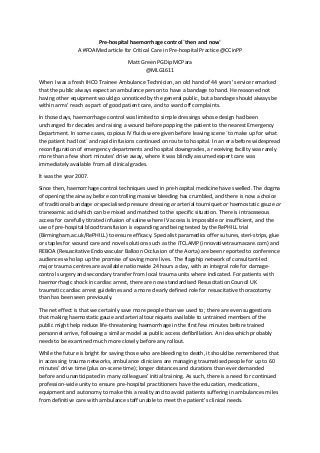
Bleeding then and now for CCinPP
- 1. Pre-hospital haemorrhage control `then and now` A #FOAMed article for Critical Care in Pre-hospital Practice @CCinPP Matt Green PGDip MCPara @MLG1611 When I was a fresh IHCD Trainee Ambulance Technician, an old hand of 44 years’ service remarked that the public always expect an ambulance person to have a bandage to hand. He reasoned not having other equipment would go unnoticed by the general public, but a bandage should always be within arms’ reach as part of good patient care, and to ward off complaints. In those days, haemorrhage control was limited to simple dressings whose design had been unchanged for decades and raising a wound before popping the patient to the nearest Emergency Department. In some cases, copious IV fluids were given before leaving scene `to make up for what the patient had lost` and rapid infusions continued on route to hospital. In an era before widespread reconfiguration of emergency departments and hospital downgrades, a receiving facility was rarely more than a few short minutes’ drive away, where it was blindly assumed expert care was immediately available from all clinical grades. It was the year 2007. Since then, haemorrhage control techniques used in pre-hospital medicine have swelled. The dogma of opening the airway before controlling massive bleeding has crumbled, and there is now a choice of traditional bandage or specialised pressure dressing or arterial tourniquet or haemostatic gauze or tranexamic acid which can be mixed and matched to the specific situation. There is intraosseous access for carefully titrated infusion of saline where IV access is impossible or insufficient, and the use of pre-hospital blood transfusion is expanding and being tested by the RePHILL trial (Birmingham.ac.uk/RePHILL) to ensure efficacy. Specialist paramedics offer sutures, steri-strips, glue or staples for wound care and novel solutions such as the iTCLAMP (innovativetraumacare.com) and REBOA (Resuscitative Endovascular Balloon Occlusion of the Aorta) are been reported to conference audiences who lap up the promise of saving more lives. The flagship network of consultant-led major trauma centres are available nationwide 24 hours a day, with an integral role for damage- control surgery and secondary transfer from local trauma units where indicated. For patients with haemorrhagic shock in cardiac arrest, there are now standardised Resuscitation Council UK traumatic cardiac arrest guidelines and a more clearly defined role for resuscitative thoracotomy than has been seen previously. The net effect is that we certainly save more people than we used to; there are even suggestions that making haemostatic gauze and arterial tourniquets available to untrained members of the public might help reduce life-threatening haemorrhage in the first few minutes before trained personnel arrive, following a similar model as public access defibrillation. An idea which probably needs to be examined much more closely before any rollout. While the future is bright for saving those who are bleeding to death, it should be remembered that in accessing trauma networks, ambulance clinicians are managing traumatised people for up to 60 minutes’ drive time (plus on-scene time); longer distances and durations than ever demanded before and unanticipated in many colleagues’ initial training. As such, there is a need for continued profession-wide unity to ensure pre-hospital practitioners have the education, medications, equipment and autonomy to make this a reality and to avoid patients suffering in ambulances miles from definitive care with ambulance staff unable to meet the patient’s clinical needs.